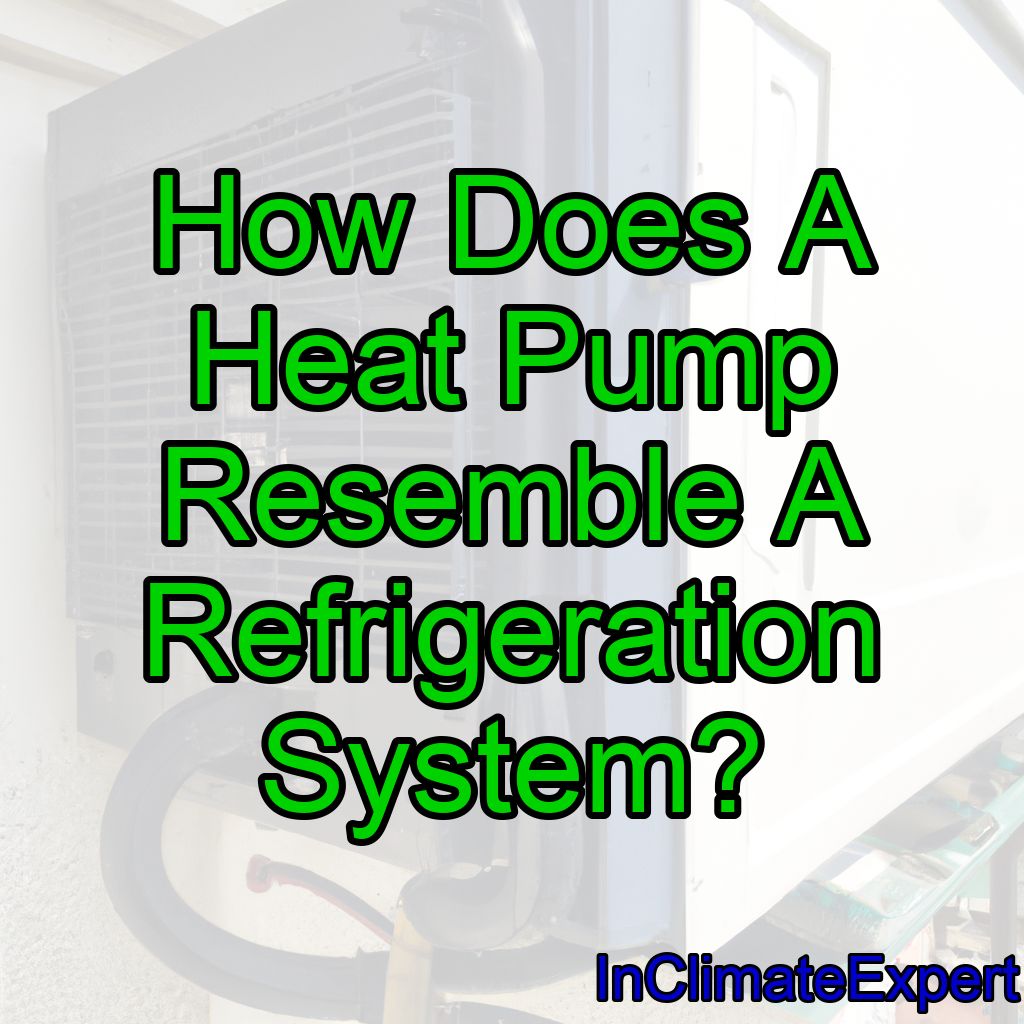Have you ever wondered about the similarities between a heat pump and a refrigeration system? Despite their different functions, these two systems share many commonalities.
A heat pump resembles a refrigeration system as both use the same basic principle of transferring heat by circulating a refrigerant through a cycle of evaporation and condensation.
In this article, we will explore how a heat pump resembles a refrigeration system and why this knowledge is crucial for understanding the technology behind these systems.
Firstly, it’s important to understand the basic principles of both systems. A refrigeration system works by removing heat from an enclosed space and releasing it into the surrounding environment. On the other hand, a heat pump transfers heat from one area to another, either into or out of a building depending on whether heating or cooling is required.
Both systems rely on the same fundamental mechanism – the transfer of energy in the form of heat. By exploring how these two systems are similar, we can gain a deeper appreciation for the engineering behind them and potentially uncover new ways to innovate in this field.
Fundamentals Of Heat Pumps
Heat pumps are innovative systems that offer an efficient way of heating and cooling homes. They work by transferring heat from one location to another, which is similar to how refrigeration systems operate.
A heat pump resembles a refrigeration system in that both use a compressor to circulate a refrigerant, absorb heat from one area, then release it in another area.
Moreover, both types of systems work based on the principle of phase change. In other words, they rely on the fact that when a refrigerant absorbs heat, it changes from a low-pressure gas to a high-pressure liquid. When this liquid is released into the evaporator coil, it reverts back to its gaseous state and absorbs more heat. This process continues until the desired temperature is reached.
By understanding the fundamentals of heat pumps, we can better appreciate their similarities with refrigeration systems and understand how they can be used for heating and cooling purposes in our homes.
Understanding Refrigeration Systems
Refrigerant is a compound that is used in refrigeration systems to help move heat from one place to another. It’s pressurized and circulated through the system, and its temperature and pressure determine how effective it is at transferring heat. The cooling cycle is the process of using refrigerant to cool a space or an object. The compressor is the machine that compresses the refrigerant and increases its pressure and temperature. The condenser is the part of the system that cools the refrigerant which is then sent through an expansion valve where it evaporates and absorbs heat. The evaporator is where the heat is removed from the air or object and the refrigerant is re-cooled. The heat exchanger is used to transfer the heat from the refrigerant to the outside environment. Refrigeration capacity is the amount of heat that a system can remove from an area or object. Refrigeration efficiency is the ratio of the amount of heat removed from an area or object to the energy used to remove the heat. Refrigeration load is the amount of heat energy that must be removed from an area or object to maintain a desired temperature. Superheat is the temperature of the refrigerant above the boiling point of the refrigerant. Subcooling is the process of cooling the refrigerant below its boiling point. Refrigeration piping is a system of pipes used to move the refrigerant throughout the system. Refrigerator components include the compressor, condenser, evaporator, expansion valve, and heat exchanger.
Refrigerant
Have you ever wondered how your refrigerator keeps your food cold?
It’s all thanks to the refrigerant! This magical substance circulates through the system, absorbing heat from inside the fridge and releasing it outside.
But did you know that a heat pump works in a similar way?
The only difference is that instead of cooling one space, it can both cool and heat different areas of a building.
Both systems use a compressor to circulate the refrigerant, and both rely on the phase change of the refrigerant from liquid to gas (and back to liquid) to transfer heat.
So next time you’re enjoying a cold drink or cozying up in front of your heat pump, remember that they have more in common than you might think!
Pressure
Now that we understand the role of refrigerants in cooling and heating systems, let’s talk about pressure.
Pressure plays a crucial role in refrigeration systems as it determines the state of the refrigerant – whether it’s a liquid or gas.
In fact, pressure is what causes the refrigerant to change states, which is essential for heat transfer.
But why does pressure matter?
Well, when compressed, gases become hotter and when expanded, they become cooler.
This principle is used in both cooling and heating systems to transfer heat from one area to another.
So next time you’re enjoying your cool air or warm cozy room, remember that it’s all thanks to the power of pressure!
Cooling Cycle
Now that we have a better understanding of pressure in refrigeration systems, let’s dive into the cooling cycle.
This is where the magic happens – transforming hot air into cool and comfortable temperatures.
The cooling cycle starts with the compressor compressing the refrigerant, which causes it to become hot and high-pressure gas.
Next, the refrigerant flows through the condenser where it cools down and turns into a high-pressure liquid.
From there, it moves through an expansion valve that reduces its pressure and causes it to turn into a low-pressure liquid.
Finally, the low-pressure liquid enters the evaporator where it absorbs heat from the surrounding air, turning back into a low-pressure gas and completing the cycle.
It’s incredible how this process can create such a dramatic change in temperature, but that’s just one of many innovative applications of refrigeration technology.
Compressor
Now that we have a grasp of the cooling cycle in refrigeration systems, let’s take a closer look at the first step – the compressor.
This is where all the action begins, as it compresses the refrigerant and transforms it into a hot and high-pressure gas. It’s fascinating to think about how this one component can kickstart the entire process that leads to comfortable indoor temperatures.
But what makes compressors even more impressive is how they have evolved over time, becoming more energy-efficient and environmentally friendly.
Let’s delve deeper into the world of compressors and discover how they play an essential role in modern refrigeration systems.
Similarities Between Heat Pumps And Refrigeration Systems
Understanding how refrigeration systems work is essential to understanding the similarities between them and heat pumps. Both systems operate on the principle of transferring heat from one location to another using a refrigerant. However, while refrigeration systems are designed to transfer heat from a cooled space to the environment, heat pumps are designed to transfer heat from a cooler space to a warmer space.
One similarity between the two systems is their use of a compressor to circulate the refrigerant through the system. The compressor compresses the refrigerant, causing it to release heat and condense into a liquid state.
From there, it flows through an expansion valve, where it expands and absorbs heat before returning to the compressor. This process allows both systems to maintain temperature control in their respective environments.
The benefits of combining heat pumps and refrigeration systems go beyond just temperature control. By utilizing both systems together, businesses can reduce energy consumption and lower their carbon footprint. In addition, this hybrid approach allows for greater flexibility in managing temperature control in different areas of a building or facility.
With advancements in technology, this innovative solution is becoming more accessible and affordable for businesses looking to increase efficiency while reducing their impact on the environment.
Benefits Of Combining Heat Pumps And Refrigeration Systems
Combining heat pumps and refrigeration systems has numerous benefits that can satisfy even the most innovative minds.
Firstly, both systems share common components such as compressors, evaporators, and condensers. Since they function similarly, it’s easy to integrate them together. By doing so, it creates a more efficient system that saves energy and space.
Secondly, combining these two systems allows for multiple applications. For example, it enables the cooling of rooms in summer while heating them during winter. Moreover, they can be used to improve industrial processes like food preservation or air conditioning in large buildings.
These benefits make it a perfect solution for those who desire innovation in their lives.
By combining heat pumps and refrigeration systems, we open doors to endless possibilities. It’s an exciting prospect that can provide sustainable solutions to various industries and households alike without sacrificing performance or efficiency.
Conclusion
In conclusion, understanding the similarities between heat pumps and refrigeration systems is crucial for anyone seeking to maximize energy efficiency in their building.
Both systems rely on the transfer of heat from one location to another, with a refrigerant acting as the medium for this transfer.
By reversing the direction of this transfer, heat pumps are able to both cool and heat a space.
While both heat pumps and refrigeration systems have been used for decades, recent advances in technology have made it possible to combine these two systems into one highly efficient unit.
By utilizing waste heat generated by refrigeration systems, heat pumps can operate at even higher levels of efficiency, reducing energy consumption and costs.
As more and more buildings seek to reduce their carbon footprint and increase sustainability efforts, combining heat pumps and refrigeration systems will likely become increasingly popular.
Not only does this approach offer significant energy savings, but it also reduces the need for separate heating and cooling systems in a building.
By understanding these fundamentals, individuals can make informed decisions about how to best optimize their building’s HVAC system.




